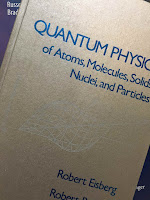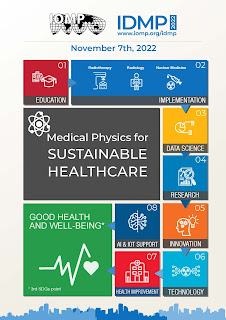In Section 14.4 of Intermediate Physics for Medicine and Biology, Russ Hobbie and I discuss molecular energy levels. In particular, we examine translational, rotational, and vibrational levels. When analyzing rotational levels, we consider a simple diatomic molecule and divide the motion into two parts: a uniform translation of the center of mass, and a rotation about the center of mass. We show that the rotational energy can be written as ½Iω2, where ω is the rotational angular frequency and I is the moment of inertia. The moment of inertia is I = [m1 m2/(m1 + m2)] R2, where m1 and m2 are the mass of the two atoms making up the diatomic molecule, and R is the distance between them. In quantum mechanics, the spacing of rotational energy levels depends on I.
Later in the same section, Russ and I consider vibrational motion. However, we don’t do a detailed analysis for a diatomic molecule, like we did for rotational motion. In this blog post, I will remedy that situation and present the analysis of vibrations of a diatomic molecule. Our goal is to derive an expression for the vibration frequency in terms of the masses of the two atoms and the spring constant connecting them.
Let’s do the analysis in one dimension. Consider two atoms with mass m1 and m2 connected by a spring with spring constant k. The position of m1 is x1, and the position of m2 is x2.
First, write down Newton’s second law for each atom.
m1 d2x1/dt2 = − k (x1 − x2 ) ,
m2 d2x2/dt2 = k (x1 − x2 ) .
Next, define two new variables, as we did for rotational motion: x, the position of the center of mass, and X, the distance between the two masses
x = [m1/(m1+m2)] x1 + [m2/(m1+m2)] x2 ,
X = x1 − x2 .
Then, rewrite Newton’s second law in terms of x and X. After some algebra, we get two equations
(m1+m2) d2x/dt2 = 0
[m1m2/(m1+m2)] d2X/dt2 = − kX
The first equation represents a free particle of mass M, where
M = m1+m2 ,
and the second equation represents a bound particle with spring constant k and mass m (often called the reduced mass)
m = m1m2/(m1+m2)
.
The angular frequency of the vibration is therefore
ω = √(k/m)
(If you don’t follow that last step, see Appendix F of IPMB).
We have reached our goal: the angular frequency of the vibration, ω, written in terms of k, m1, and m2
ω = √[k (m1+m2)/m1m2]
In quantum mechanics, the energy levels depend on ω, and therefore on the reduced mass m.
If m1 >> m2 then m is approximately m2. Likewise, if m2 >> m1 then m is approximately m1. For example, if you want the vibration frequency of hydrogen chloride (HCl), the reduced mass is close to the mass of the hydrogen atom.
If m1 = m2 = μ (like for molecules such as O2 and N2), then the reduced mass m is equal to μ/2. It’s that factor of two in the denominator that’s the surprise.
 |
| Quantum Physics of Atoms, Molecules, Solids, Nuclei and Particles, by Eisberg and Resnick. |
The relationship between m, m1, and m2 can be written
1/m = 1/m1 + 1/m2 .
This looks just like the equation for adding resisters in parallel.
If you want to learn more, I suggest looking at Chapter 12 of Quantum Physics of Atoms, Molecules, Solids, Nuclei, and Particles, by Robert Eisberg and Robert Resnick, often cited in IPMB.






